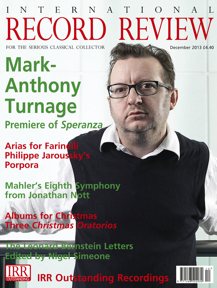Texte paru dans: / Appeared in:
*

International Record Review - (12/2013)
Pour
s'abonner / Subscription information
Glossa
GCD921515

Code-barres / Barcode : 8424562215153 (ID353)
Handel composed his Italian serenata for soprano, mezzo and bass, Aci, Galatea e Polifemo during his three-month stay in Naples from April to July 1708 . It was commissioned for the wedding celebrations of the Duke of Alvito to Princess Beatrice Tocco di Montemiletto by the bride’s cultured aunt, Duchess Donna Aurora Sanseverino di Laurenzana, who later reused it for her own son’s wedding in 1711. Oddly, star-crossed lovers was a popular theme for wedding serenatas in early eighteenth-century Italy. This work, no exception, concerns the tragic story of the shepherd Acis and his beloved, the sea nymph Galatea: the cruel and jealous giant cyclops, Polyphemus, pursues Galatea, whose rnocking rejection goads him to murder Acis, at which the despairing nymph hurls herself to her death in the sea. This theme gains further poignancy when one learns both bridegrooms died very soon after their respective weddings.
Handel’s Italian serenata has been overshadowed by his later English-language mini pastoral opera of 1718, Acis and Galatea; but there have been four previous recordings with period instruments and even a couple with modem singers and orchestras . It is a wonderful work deserving a lot more attention, despite its relatively poor libretto, containing some of the catchiest music Handel wrote (which his repeated self-borrowing from it confirms) . It has no introductory sinfonia (whether it has been lost or never was is uncertain) and thus opens with a duet in which Acis and Galatea celebrate their love with radiantly happy, effortlessly contrapuntal and supremely tuneful music. Each character has five arias and there are several duets and terzettos as well.
Somewhat oddly to the modern mind, the shepherd Acis is a soprano (and a rather high one at that), while his beloved is an alto. It is unknown who sang these two roles in the original performance, but castrati sang them both in the 1711 repeat for Aurora Sanseverino’s son. Fabio Bonizzoni’s Acis and Galatea are the Italian soprano Roberta Invernizzi and French mezzo Blandine Staskiewicz. While the latter (who is new to me) sometimes sounds a little masculine despite her female role, no one could mistake Invernizzi for a man: she seems to make no concession to her character’s masculinity in her singing. I have complained before about Invernizzi’s weaknesses as a Baroque singer. Despite her vocal agility and refined ear for embellishment, hers is not a fundamentally beautiful voice, a problem exacerbated by poor control of pitch and vibrato. Suffice it to say that these features have persisted on this recording, with the result that ‘she often sounds well past her prime as a singer, once again undermining her undoubted skills as an actress. Of all the comparisons, only the sweet but comparatively cool Emma Kirkby does not share Invernizzi’s penchant for excessive vibrato; but this feature aside, Stephanie True’s account of the role is preferable to Invernizzi’s. The one exception in Invernizzi’s unsatisfying performance is Acis’s death aria, ‘Verso già l’alma col sangue’, which, her voice hushed and vibrato for once subdued and supported by insistently pulsating strings, she delivers with considerable emotional impact.
Staskiewicz, although by no means ideal in historically informed stylistic terms, produces a considerably more attractive performance, particularly in her sadder arias, ‘Se m’ami, o caro’, in which she finds an eloquent pathos, and the highly athletic ‘Del mar fra l’onde’ after Acis’s murder, which combines fury, despair and sadness . Like Invernizzi, Staskiewicz is unfazed by fond passages and also ornaments her arias tastefully and fairly generously. Of all the comparison recordings, Staskiewicz is the most satisfactory, avoiding the overblown tone of Sara Mingardo (for Emmanuelle Haïm and Antonio Florio) and singing with greater confidence than Marco Vitale’s Galatea , Luciana Mancini.
The third character, Polifemo, has some of the best music Handel ever wrote for the bass voice. It requires a singer with a particularly wide range from basso profundo up into the tenor register, as established by Polifemo’s murky, self-pitying aria, ‘Fra l’ombre e gl’orrori’ (the moment when he forms his intention to murder Acis) , and also great agility, as in ‘Impara, ingrate, impara’ (in which he blames Galatea for causing him to kill Acis), and especially the threatening ‘ Sibilar 1’angui d’Aletto’ . In his informative programme notes, Carlo Vitali identifies the Neapolitan priest Antonio Manna as the most likely singer of Polifemo. Manna was employed as a bass singer by the Habsburgs in Vienna, but retired on medical grounds and returned to his native city in 1705. There (presumably contrary to his doctor’s advice) he continued to lead a busy singing career. Bonizzoni’s Polifemo is the Argentine bass baritone Lisandro Abadie, who has an attractive voice capable of reaching both extremes of his part’s range, despite some fleeting lapses of control at the bottom end. Although he does not equal David Thomas’s legendary bottom-of-the-range control and fullness of tone, he certainly matches him in his characterization of this most complex and at times semi-comical character in the work. None of the other ‘Polifemi’ can match Abadie’s technically accomplished singing and expression. Mitchell Sandler, for Vitale, too often sounds limp and suffers from an excessive shake, while, for Haïm and Florio respectively, Laurent Naouri’s and Antonio Abete’s sagging vibrato (sorry to mention it again) and wandering pitch are disappointing.
As far as the singing is concerned, we continue to await a more thoroughgoing historically informed performance of this delightful work. As always, in all other respects Bonizzoni has taken considerable care in his performing choices. The first and second violins are limited to four apiece, to reflect the most likely first performance conditions, and there is no lutenist in the continuo section. Tempos tend towards the fast and lithe, with considerable rhythmic sensitivity from both strings and basso continuo. As in previous recordings, Bonizzoni’s apparently separately miked harpsichord sounds rather too prominent; but he provides an unfailingly inventive and lively basso continuo that is often reminiscent in its fond playfulness of Ton Koopman at his best.
A note in the booklet explains that this recording ends
Bonizzoni’s survey for Glossa of Handel’s Italian cantatas and serenatas.
Therefore, there is a bonus track: the original final duetto of Clori,
Tirsi e Fileno (HWV96), which Bonizzoni recorded with Handel’s latenr
replacement terzetto in 2008. It makes a lovely finale to the project.
Fermer la fenêtre/Close window
Cliquez l'un ou l'autre
bouton pour découvrir bien d'autres critiques de CD
Click either button for many other reviews


